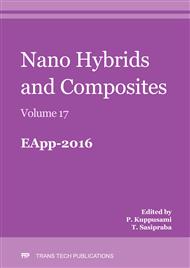[1]
Yuanbing Mao, Hongjun Zhou and Stanislaus S. Wong, Perovskite-phase Metal Oxide Nanostructures: Synthesis, Properties, and Applications, Mater. Matters, 5 (2010) 50-53.
Google Scholar
[2]
Bernadette A. Hernandez-Sanchez, Bruce A. Tuttle, James A. Voigt, Diana L. Moore, Terry J. Garino, Patrick Mahoney and Mark A. Rodriguez, Oxalate Co-precipitation Synthesis of Calcium Zirconate and Calcium Titanate Powders, SANDIA REPORT SAND2009-4743, Sandia National Laboratories, (June 2009).
DOI: 10.2172/984943
Google Scholar
[3]
L.S. Cavalcante, V.S. Marques, J.C. Sczancoski, M.T. Escote, M.R. Joya, J.A. Varela, M.R.M.C. Santos, P.S. Pizani and E. Longo, Synthesis, structural refinement and optical behavior of CaTiO3 powders: A comparative study of processing in different furnaces, J Chem. Eng. J., 143 (2008).
DOI: 10.1016/j.cej.2008.05.017
Google Scholar
[4]
R.S. André, S.M. Zanetti, J.A. Varela and E. Longo, Synthesis by a chemical method and characterization of CaZrO3 powders: Potential application as humidity sensors, Ceram. Int., 40 (2014) 16627–16634.
DOI: 10.1016/j.ceramint.2014.08.023
Google Scholar
[5]
G. Rose, Beschreibung eineiger neuer Mineralien vom Ural, Pogendorff Annalen der Physik und Chemie, 48 (1839) 551–572.
DOI: 10.1002/andp.18391241205
Google Scholar
[6]
I. Pekov, Minerals first discovered on the territory of the former Soviet Union, Ocean Pictures, Moscow, (1998) p.370.
DOI: 10.2138/am.2005.447
Google Scholar
[7]
V.M. Gazeev, A.E. Zadov, A.G. Gurbanov, N.N. Pertsev, A.V. Mokhov and A. Ya. Dokuchaev, Rare minerals of Verkhniy Chegem caldera (in skarned carbonates xenoliths in ignimbrites), Vestnik Vladikavkazskogo Nauchnogo Centra, 6 (2006) 18–27.
Google Scholar
[8]
Toshio Kimura, Molten Salt Synthesis of Ceramic Powders, Advances in Ceramics - Synthesis and Characterization, Processing and Specific Applications, Editor: Prof. Costas Sikalidis, ISBN: 978-953-307-505-1 (2011).
DOI: 10.5772/20472
Google Scholar
[9]
Sharad S. Gaikwad, Ashok V. Borhade and Vishwas B. Gaikwad, A green chemistry approach for synthesis of CaTiO3 Photocatalyst: its effects on degradation of methylene blue, phytotoxicity and microbial Study, Der Pharma Chemica, 4 (2012) 184-193.
Google Scholar
[10]
T. Kimura, M. Machida, T. Yamaguchi and R.E. Newnham, Products of Reaction Between PbO and Nb2O5 in Molten KCl or NaCl, J. Am. Ceram. Soc., 66, (1983) C195-C197.
DOI: 10.1111/j.1151-2916.1983.tb10553.x
Google Scholar


